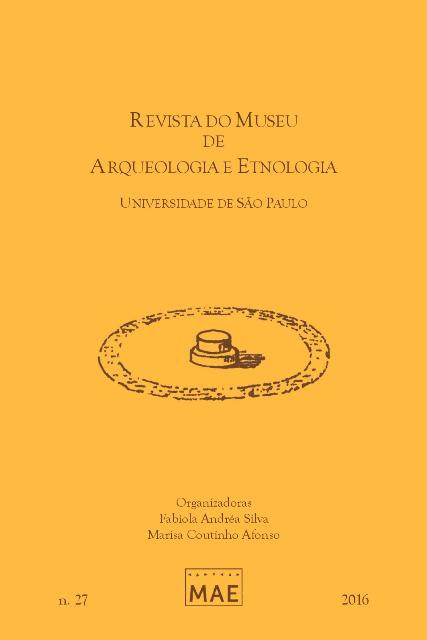The comprehension of the Kaingang territory in the West of the State of São Paulo based on the material culture: interpretative possibilities in the archaeological analysis
DOI:
https://doi.org/10.11606/issn.2448-1750.revmae.2016.137280Keywords:
Kaingang territory, Pottery technology, West of the State of São Paulo, Etnoarchaeology, Historical documentation.Abstract
The study of the material culture of contemporaneous indigenous populations is a privileged object of research and learning for the archaeologists, for it allows the comprehension of the dynamics of the production processes of material tems as well as the usage of these in the cultural construction of a group. During the historical process, the Kaingang, due to inter-ethnic contact, drastically diminished their pottery production, as well as the way they occupied and utilized the space and system of their settlements. With the intention of building interpretative models about the behavioral aspects and past social dynamics, and at the same time understand how different historic elements that come from the capitalist expansion process provoked alterations on the indigenous way of life, the approach I have been conducting my research defines a scenery of the Kaingang occupation in the West of the State of São Paulo based on data generated by archaeological interpretations on the analyses of material culture and historical documentation identified during researches in indigenous territory.the analyses of material culture and historical documentation identified during researches in indigenous territory.
Downloads
References
Drumond, C.; Philipson, J. 1947. Os túmulos Kaingang de Parapuã. Sociologia: Revista Didática e Científica, IX (4).
Gould, R.A. 1971. The Archaeologist as Ethnographer: a Case Study from Western Desert of Australia. World Archaeology, nº 31.
Gould, R.A. 1977. Some current problems in ethnoarchaeology. Experimental Archaeology. New York: Columbia University Press. Gould, R.A. 1978. Beyond Analogy in Ethnoarchaeology. In: Gould, R.A. (Ed.) Explorations in Ethnoarchaeology. Albuquerque: Univ. of New Mexico Press.
Landa, B. dos S. 2005. Os Ñandeva/Guarani e o uso do espaço na terra indígena Lindo/Jakarey, município de Japorã/MS. Tese de doutorado. Pontifícia Universidade Católica do Rio Grande do Sul, Rio Grande do Sul.
Miller Jr., T.O. 1978. Tecnologia cerâmica dos Kaingang Paulista. Arquivos do Museu Paranaense, N. S. Etnologia, Curitiba, 2. Ribeiro, D. 1986. Índios e a civilização: a integração das populações indígenas no Brasil moderno. Petrópolis: Vozes, 5. ed.
Rodrigues, R. 2007. Os Caçadores-Ceramistas do Sertão Paulista: Um estudo etnoarqueológico da ocupação Kaingang no Vale do Rio Feio/ Aguapeí. Tese de doutorado. MAE-USP. São Paulo/SP.
Rodrigues, R. 2010. Relatório Técnico das Atividades de Pesquisa. Projeto: Estudos etnoarqueológicos da população Kaingang no Oeste Paulista: produção tecnológica e ocupação espacial. Projeto: 501002/2009-0. PROCESSO: 151425/2009-4/CNPq. MODALIDADE: Pós-Doutorado Junior – PDJ.FCL/ UNESP. Araraquara/SP. Sakai, K. 1981. Notas arqueológicas do Estado de São Paulo. São Paulo: Instituto Paulista de Arqueologia, Nippon Art.
Schiffer, M.B. 1972. Archaeological Context and Systemic Context. American Antiquity, v. 2, nº37.
Schiffer, M.B. 1978. Methodological Issues in Ethnoarchaeology. In: R.A. Gould (Ed.). Exploration in Ethnoarchaeology. Albuquerque: University of New Mexico Press.
Schiffer, M.B. 1983. Toward the identification of formation processes. American Antiquity, nº48.
Silva, F.A. 2000a. As cerâmicas dos Jê do sul do Brasil e os seus estilos tecnológicos: elementos para uma etnoarqueologia Kaingang e Xocleng. In: Mota, L.T. et al. (Org.). Uri e Wãxi – estudos interdisciplinares dos Kaingang. Londrina: Ed. da Univ. Est. Londrina.
Silva, F.A. 2000b. As tecnologias e seus significados: um estudo da cerâmica dos Asuriní do Xingu e da cestaria dos Kayapó-Xikrin sob uma perspectiva Etnoarqueológica. Tese de doutorado. Faculdade de Filosofia, Letras e Ciências Humanas, Universidade de São Paulo, São Paulo.
Downloads
Published
Issue
Section
License
Copyright (c) 2016 Robson Rodrigues

This work is licensed under a Creative Commons Attribution-NonCommercial-NoDerivatives 4.0 International License.













